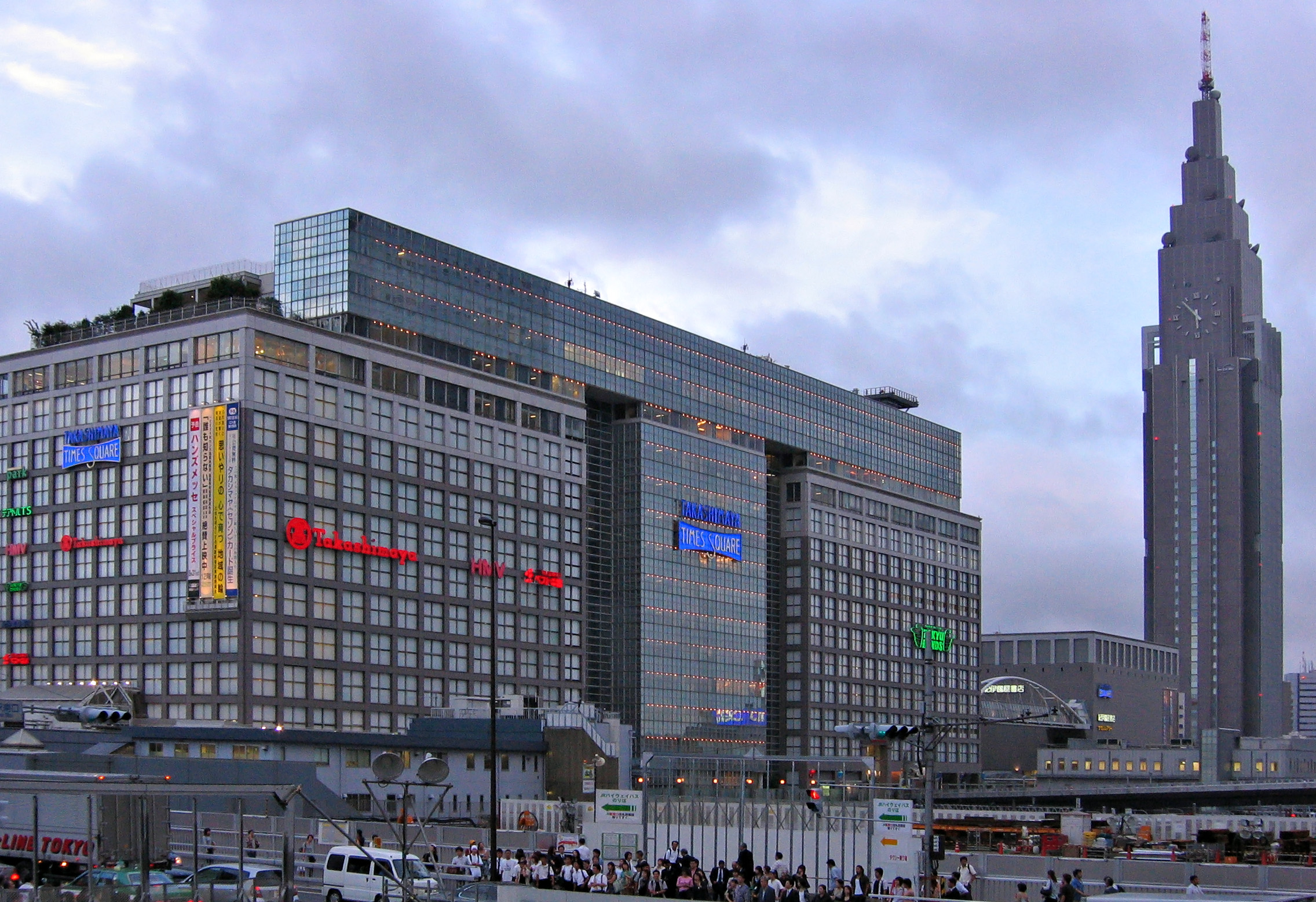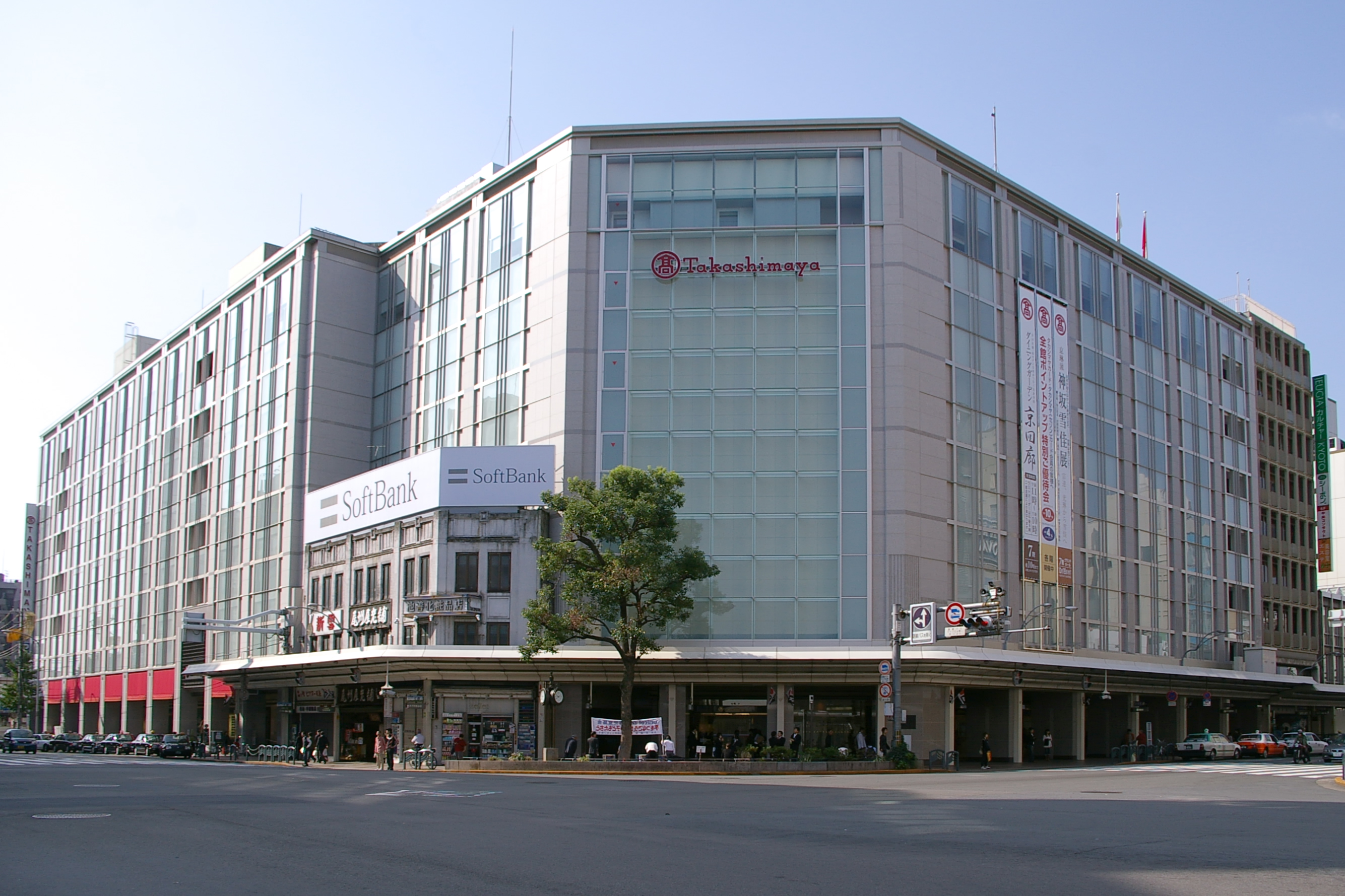|
Kawaramachi Station (Kyoto)
is the northern terminal station of the Hankyu Kyoto Main Line of Hankyu in Kyoto City, Japan. Layout The station has an island platform serving three tracks underground. Adjacent stations History This station opened as Kawaramachi Station on June 17, 1963; it was renamed to Kyoto-kawaramachi Station on October 1, 2019. Before the opening of Kawaramachi Station and Karasuma Station, the Hankyu Kyoto Main Line terminated at Ōmiya Station. Station numbering was introduced to all Hankyu stations on 21 December 2013 with this station being designated as station number HK-86. Passenger statistics In fiscal 2015 (April 2015 to March 2016), approximately 27,320,000 passengers used this station annually. For historical data, see the table below. Surrounding area The area around the station ( Shijō Kawaramachi) is one of the commercial centers of Kyoto. The real estate around the station is the most valuable in Kyoto. The Kawaramachi and Shijo streets cross over ... [...More Info...] [...Related Items...] OR: [Wikipedia] [Google] [Baidu] |
Hankyu Department Store
is a Japanese department store chain owned by , a subsidiary of H2O Retailing Corporation. Stores *Umeda, Osaka - Main Store (''Honten'') **Hankyu Men's *Kobe **formerly Sogo Department Stores * Takarazuka * Kawanishi * Senri *Takatsuki, Takatsuki **formerly Seibu Department Stores * Sanda *Nishinomiya *Hankyu Men's Tokyo (Yūrakuchō, Tokyo) - The store was reopened on October 15, 2011 (http://www.h2o-retailing.co.jp/news/pdf/2010/110121_renewal.pdf). * Ooi Shokuhinkan, Tokyo * Tsuzuki, Yokohama * Hakata, Fukuoka - opened in March 2011, as a main tenant of the renovated Hakata Station. Former stores * Shijō Kawaramachi, Kyoto - closed August 2010 Overseas franchises Uni-President Department Store Corp., a Uni-President group company, operated two stores in Taiwan under the name Uni-President Hankyu. The franchise agreement between Uni-President and H2O Retailing was terminated in 2016, renaming all stores Uni-Ustyle. *Kaohsiung, Taiwan *Taipei, Taiwan See also *Hanshin De ... [...More Info...] [...Related Items...] OR: [Wikipedia] [Google] [Baidu] |
Island Platform
An island platform (also center platform, centre platform) is a station layout arrangement where a single platform is positioned between two tracks within a railway station, tram stop or transitway interchange. Island platforms are popular on twin-track routes due to pragmatic and cost reasons. They are also useful within larger stations where local and express services for the same direction of travel can be provided from opposite sides of the same platform thereby simplifying transfers between the two tracks. An alternative arrangement is to position side platforms on either side of the tracks. The historical use of island platforms depends greatly upon the location. In the United Kingdom the use of island platforms is relatively common when the railway line is in a cutting or raised on an embankment, as this makes it easier to provide access to the platform without walking across the tracks. Advantages and tradeoffs Island platforms are necessary for any station with many th ... [...More Info...] [...Related Items...] OR: [Wikipedia] [Google] [Baidu] |
Karasuma Station
is a station on the Hankyu Kyoto Line. Layout The station has an island platform serving two tracks. Shijō Station on the Karasuma Line The is one of the two lines of the Kyoto Municipal Subway operated by Kyoto Municipal Transportation Bureau in Kyoto, Japan. On maps, diagrams and signboards, the line is colored green, and its stations are given numbers following the letter " ... subway is connected with Karasuma Station by a short underground walkway. Usage In fiscal 2015 (April 2015 to March 2016), about 33,933,000 passengers used this station annually. For historical data, see the table below. History Karasuma Station opened on 17 June 1963. Station numbering was introduced to all Hankyu stations on 21 December 2013 with this station being designated as station number HK-85. Adjacent stations References External linksKarasuma Stationfrom Hankyu Railway website Railway stations in Japan opened in 1963 Hankyu Kyoto Main Line Railway stations ... [...More Info...] [...Related Items...] OR: [Wikipedia] [Google] [Baidu] |
Takashimaya
is a Japanese multinational corporation operating a department store chain carrying a wide array of products, ranging from wedding dresses and other apparel to electronics and flatware. It has more than 12 branches strategically located in 2 regions, and 4 international branches around Asia. Takashimaya has been a member of the International Association of Department Stores from 1962 to 1997. Takashimaya was listed at #1197 on the Forbes Global 2000 list for 2006. Takashimaya is a member of the Sanwa Group keiretsu. History The first Takashimaya store was opened in Kyoto in 1831 as a sole proprietorship owned by Shinshichi Iida, a merchant from present-day Fukui Prefecture. The original store in Kyoto was only 3.6 square meters in area and specialized in selling gofuku (formal kimono). A second Kyoto store opened in 1893, followed by a Tokyo store in 1897 and an Osaka store in 1898. Takashimaya was incorporated as a gomei kaisha (unlimited liability company) in 1909 and ... [...More Info...] [...Related Items...] OR: [Wikipedia] [Google] [Baidu] |
Kamo River (Kyoto)
The is located in Kyoto Prefecture, Japan. The riverbanks are popular walking spots for residents and tourists. In summer, restaurants open balconies looking out to the river. There are walkways running alongside the river, and some stepping stones that cross the river. The water level of the river is usually relatively low; less than one meter in most places. During the rainy season, however, the walkways sometimes flood in their lower stretches. Geography The Kamo River has its source in the mountains in the area of Mount Sajikigatake, around the boundary of Kumogahata village and Keihoku village in the northern ward of Kyoto. Flowing into the Kyoto Basin from the city area called Kamigamo in the same northern ward of the city, from there it bends south-east and, around the spot known as Demachi in the Kamigyō (or "Upper Kyoto" ward), joins with the Takano River which flows down from the northeastern direction, and there changes direction to due south through Kyoto ... [...More Info...] [...Related Items...] OR: [Wikipedia] [Google] [Baidu] |
Kawaramachi Street
runs parallel to the west bank of the Kamo River on the eastern side of Kyoto, Japan. Its intersection with Shijō Street is called Shijō Kawaramachi and is a leading shopping district of the city. Both Shijō and Kawaramachi Street are protected with smoking bans. Overview Edo Period Located outside of Heian-kyō and runs almost parallel to Toyotomi Hideyoshi's Odoi. It is thought that it was established when the city expanded to the Kamo River in the early Edo Period. From north to south it extends from Aoibashi Nishizume to Jujō Street. North of Aoibashi Nishizume its name changes to Shimogamo Main Street. South of Jujō Street it curves along the Kamo River and joins with Kuzebashi Street. The stretch between Sanjō Street and Shijō Street is one of Kyoto's downtown shopping streets. Because the portion between Shijō Street and Kamijuzuyacho Street runs parallel to the Kamo River bending in a North-North-East and South-South-West direction it naturally interse ... [...More Info...] [...Related Items...] OR: [Wikipedia] [Google] [Baidu] |
Shijō Kawaramachi
is a vibrant part of central Kyoto, Japan where Shijō and Kawaramachi Streets intersect. Kawaramachi Street runs parallel to the Kamo River on the eastern side of Kyoto, while Shijō Street runs east–west through the center of the city. Stores Two of four corners of the intersection are occupied by department stores: Takashimaya at the southwest corner and Kyoto Marui at the southeast corner. Kyoto Marui opened on April 27, 2011 replacing Hankyu Department Store, which closed on August 22, 2010. Railway station Kyoto-kawaramachi Station is the terminal of the Hankyu Kyoto Line (Hankyu Railway) in Kyoto. The underground station lies beneath the Shijō Kawaramachi intersection. Passengers may change trains from Kyoto-kawaramachi Station to Gion-Shijō Station (Keihan Railway Keihan Main Line), which is located beyond the Kamo River. The real estate around Kawaramachi station at one time ranked among the most valuable in Japan before the real estate bubble burst in the earl ... [...More Info...] [...Related Items...] OR: [Wikipedia] [Google] [Baidu] |
Station Numbering
Station numbering is a sign system which assigns station codes consisting of a few letters and numbers to train stations. It aims to facilitate navigation for foreign travelers not familiar with the local language by using globally understood characters (Latin letters and Arabic numbers). The system is now in use by various railway companies around the world such as in Mainland China, Indonesia, Japan, South Korea, Singapore, Taiwan, Thailand, and the United States. History Station numbering first introduced—but to less fanfare—in South Korea, by the Seoul Metropolitan Subway in 1983 as a section of Seoul Subway Line 2 ( Euljiro 1-ga to Seongsu) was opened. Its first usage in Japan was in the Nagasaki Electric Tramway where it was introduced in May 1984."History of Nagasaki Electric Tramway line transition", ''Stadtbahn'' issue 9, April 1984 The Tokyo subway system introduced station numbering in 2004. Sports events are usually the turning point for the introduction of s ... [...More Info...] [...Related Items...] OR: [Wikipedia] [Google] [Baidu] |
Ōmiya Station (Kyoto)
is a railway station built underground in Nakagyo-ku, Kyoto, Kyoto, Japan. Hankyu Kyoto Line serves this station. Keifuku Electric Railroad Arashiyama Main Line terminus Shijō-Ōmiya Station locates nearby. The station opened on March 31, 1931 as Keihan Kyoto Station of the Shinkeihan Line, then operated by Keihan Electric Railway. After the Shinkeihan Line became the Hankyu Kyoto Line, the station was called Hankyu Kyoto Station. Since June 17, 1963 when the Hankyu Kyoto Line was extended to Kawaramachi Station, the station is no longer terminus and is called Ōmiya Station, after the street name. The station has two side platforms. One track serves trains bound for Kawaramachi and the other serves trains bound for Umeda is a major commercial, business, shopping and entertainment district in Kita-ku, Osaka, Japan, and the city's main northern railway terminus (Ōsaka Station, Umeda Station). The district's name means "plum field". History Umeda was historical .... Befo ... [...More Info...] [...Related Items...] OR: [Wikipedia] [Google] [Baidu] |
Kyoto
Kyoto (; Japanese: , ''Kyōto'' ), officially , is the capital city of Kyoto Prefecture in Japan. Located in the Kansai region on the island of Honshu, Kyoto forms a part of the Keihanshin metropolitan area along with Osaka and Kobe. , the city had a population of 1.46 million. The city is the cultural anchor of a substantially larger metropolitan area known as Greater Kyoto, a metropolitan statistical area (MSA) home to a census-estimated 3.8 million people. Kyoto is one of the oldest municipalities in Japan, having been chosen in 794 as the new seat of Japan's imperial court by Emperor Kanmu. The original city, named Heian-kyō, was arranged in accordance with traditional Chinese feng shui following the model of the ancient Chinese capital of Chang'an/Luoyang. The emperors of Japan ruled from Kyoto in the following eleven centuries until 1869. It was the scene of several key events of the Muromachi period, Sengoku period, and the Boshin War, such as the Ōnin War, the Ho ... [...More Info...] [...Related Items...] OR: [Wikipedia] [Google] [Baidu] |






